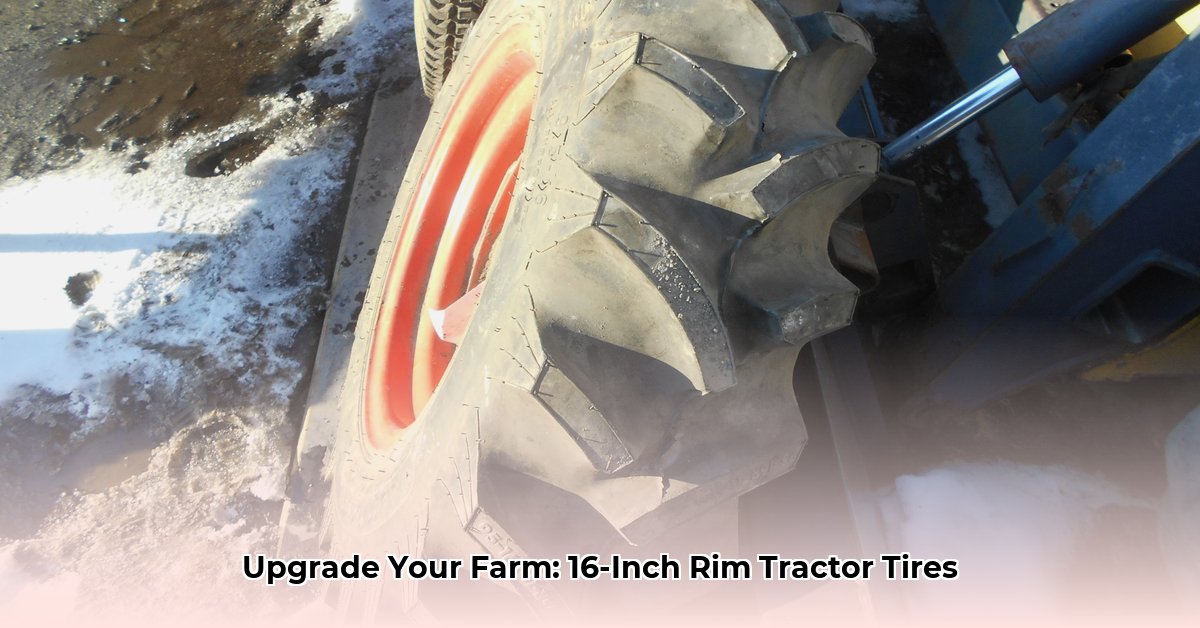
Optimizing Sustainability and Efficiency with 16-Inch Rim Tractor Tires
16-inch rim tractor tires represent a seemingly minor detail with a significant impact on farm profitability and environmental sustainability. Selecting the appropriate tires isn't merely about tractor mobility; it's about maximizing efficiency, safeguarding soil health, and minimizing environmental impact. The tire acts as the crucial interface between the machinery and the land, making the choice paramount. For more tire options, check out these other tire sizes.
Fuel Efficiency: Lowering Costs and Carbon Footprint
Fuel costs significantly impact farm profitability. However, appropriately selected and maintained 16-inch rim tractor tires can substantially reduce fuel consumption. Lower rolling resistance, achieved through correct inflation and suitable tread patterns, directly translates to less fuel needed for the same amount of work. This results in direct cost savings and a smaller carbon footprint. While the exact fuel savings vary depending on factors like tread pattern and pressure, studies indicate substantial potential benefits. Minimizing slippage by optimizing tire pressure and ground grip is vital for maximizing fuel economy. How can precision inflation monitoring further enhance fuel efficiency?
Soil Compaction: Protecting Soil Health and Yield
Soil compaction, often overlooked, negatively impacts crop yields and land health. Heavy machinery can compact soil, reducing water infiltration and hindering root growth. While 16-inch rim tires offer a good balance of maneuverability and load capacity, improper management contributes to compaction. Wider tires distribute weight more effectively, reducing localized soil pressure. This is analogous to the pressure difference between high heels and flat shoes—flat shoes distribute the weight across a larger surface area, leading to less concentrated pressure. Proper tire inflation is crucial; underinflation causes excessive compaction, while overinflation can damage soil structure. Finding the optimal tire pressure is key to balancing traction and minimizing soil impact. What are the long-term effects of soil compaction on crop yields, and how can tire pressure monitoring systems mitigate these effects?
Tire Lifespan and Environmental Responsibility
Tire lifespan significantly influences both operating costs and environmental impact. Longer-lasting tires reduce the need for replacements, thereby minimizing waste from tire manufacturing and disposal. 16-inch rim tires, like all tires, are manufactured from various materials, some more sustainable than others. Many manufacturers are developing tires using recycled or bio-based materials, significantly reducing the environmental footprint compared to conventional rubber tires. While these sustainable options are promising, further research is needed to fully assess their long-term durability and performance under real-world conditions. What are the key technological advancements that are driving the development of more sustainable tire materials?
Precision Agriculture: Integrating Smart Tires for Optimized Farming
Precision agriculture leverages technology to optimize farming processes and enhance efficiency. Integrating smart sensors into tractor tires for real-time tire pressure monitoring is an exciting development. This allows for immediate adjustments, optimizing fuel usage and minimizing soil compaction. Imagine a future where your tractor tires communicate directly with your farm management system! This data-driven approach allows for fine-tuning tire management, maximizing efficiency and environmental responsibility while integrating 16-inch rim tires into this sophisticated system. What are the potential benefits and challenges of integrating smart tire technology into existing farming operations?
Actionable Steps for Sustainable Tire Management
Follow these steps to maximize the benefits of your 16-inch rim tractor tires:
- Regular Pressure Checks: Check tire pressure regularly, adjusting based on conditions and recommended pressures.
- Tire Selection: Choose tires appropriate for your soil type and farming operations. Different tires have different capabilities.
- Precision Inflation: Maintain optimal tire pressure to avoid both underinflation (excessive compaction) and overinflation (tire and soil damage).
- Rotation and Alignment: Rotate tires regularly for even wear and extended lifespan. Ensuring proper wheel alignment is critical.
- Responsible Recycling: Utilize responsible tire recycling options at end-of-life.
Weighing the Advantages and Disadvantages
This table summarizes the pros and cons of using 16-inch rim tractor tires in sustainable agriculture:
| Feature | Pros | Cons |
|---|---|---|
| Soil Compaction | Reduced compaction (with proper inflation) compared to narrower tires. | Susceptible to compaction if improperly inflated or used on sensitive soils. |
| Fuel Efficiency | Potential for significant fuel savings with appropriate pressure and tread. | Fuel savings depend on terrain and operating conditions. |
| Lifespan | Long lifespan with proper maintenance. | Reduced lifespan possible due to underinflation, harsh terrain, or overloading. |
| Cost | Generally cost-effective. | May not be ideal for all applications or soil conditions. |
| Availability | Widely available. | Limited availability of sustainable alternatives in some regions. |
Choosing the right 16-inch rim tractor tires is a crucial element of sustainable farming practices. Following these recommendations will have a positive impact on your farm's economic viability and its environmental footprint. Attention to detail is key!